Frank Nelson Pierce, 1862 - 1943
by Brian Stevenson
last updated March, 2020
F.N. Pierce was an amateur microscopist and entomologist who is especially notable for his work on defining lepidoptera species. Pierce focused on butterfly and moth genitalia as a key, on the principal that individuals within a species may vary somewhat in size, coloration, or wing patterns, but their genitals cannot differ due to the requirement of precise fit between male and female. Pierce published his works on British lepidoptera in a series of books during the early 1900s.
A microscope was essential for identification keys such as Pierce's. He was an established expert at both use of the instrument and preparation of slides. He produced high-quality microscope slides to enable him to detect structural differences among species, and to serve as examples for generation of instructive illustrations (Figures 1 and 3).
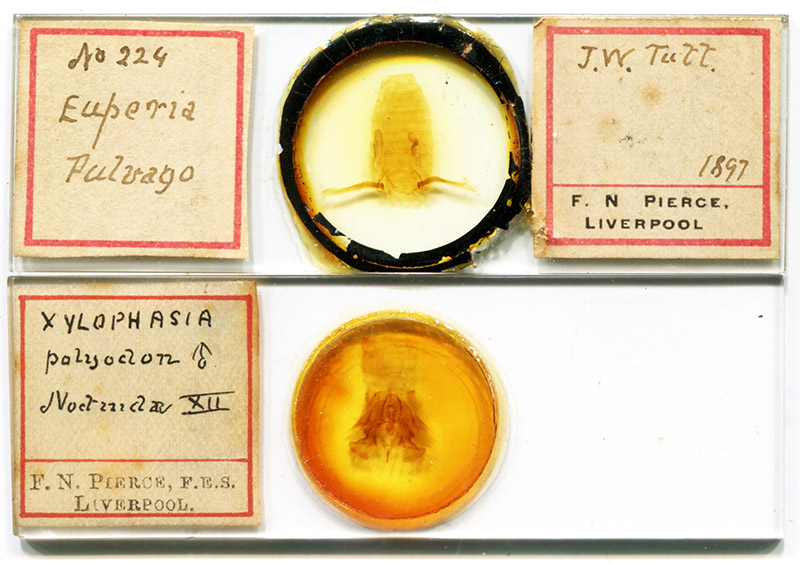
Figure 1.
Microscope slides by Frank N. Pierce. The upper slide, a section of Euperia fulvago, is dated 1897, and includes the name of fellow entomologist James William Tutt (1858-1911) – it is not clear whether Tutt provided the specimen to Pierce, or if he made a presentation on this species during 1897. The lower slide shows genitalia of a male "polyodon", and reference to plate 12 of Pierce's 1909 work on identifying the Noctuidae group of lepidoptera (see Figures 2-4).

Figure 2.
Photomicrographs of a male polyodon genitals, prepared ca. 1909 by F.N. Pierce (see Fig. 1). Images with a 3.45x objective lens and a C-mounted digital SLR camera.
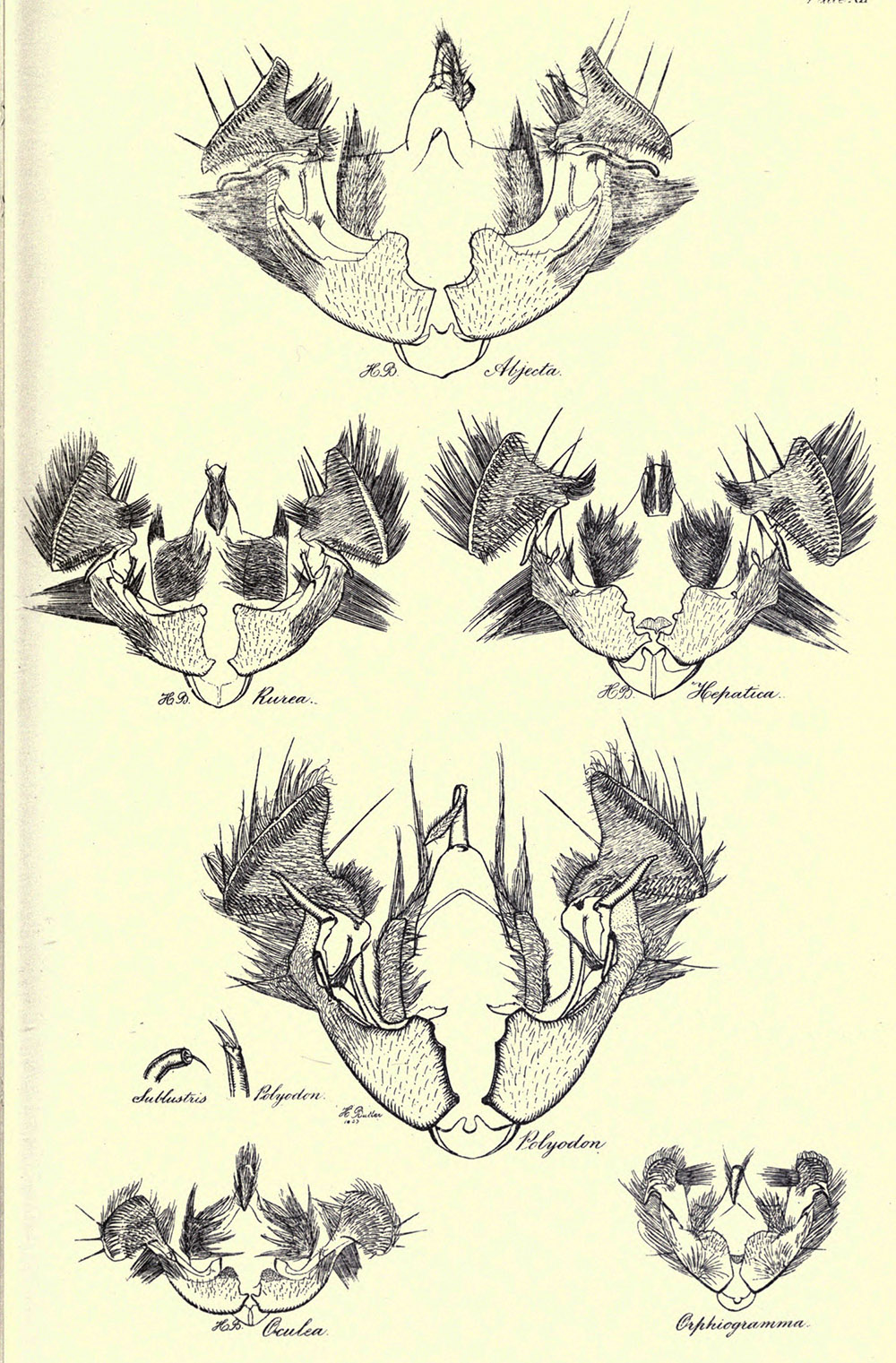
Figure 3.
Plate 12 from F.N. Pierce's 1909 book, "The Genitalia of the Group Noctuidae of the Lepidoptera of the British Islands", which includes an illustration of polyodon.
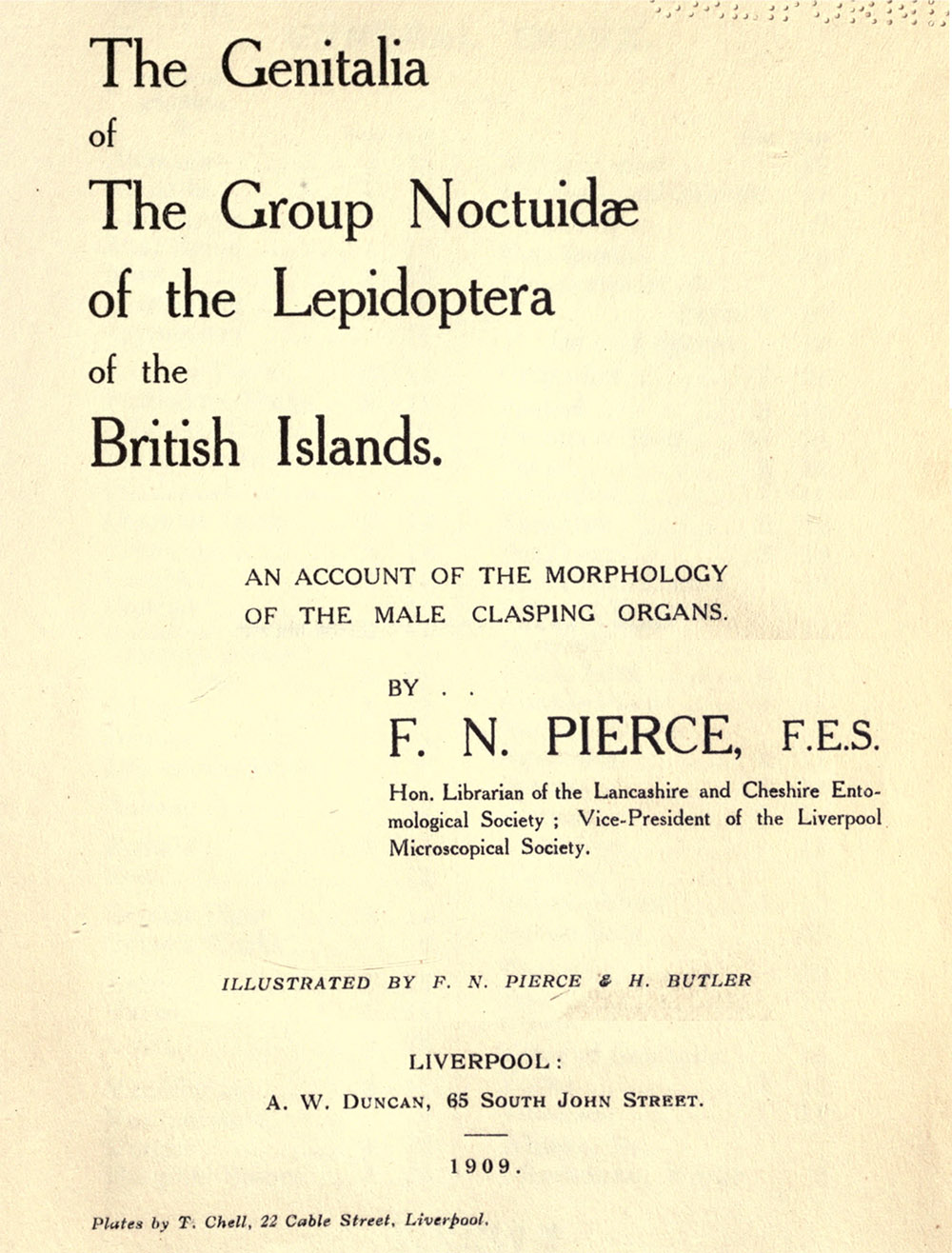
Figure 4.
Title page from "The Genitalia of the Group Noctuidae of the Lepidoptera of the British Islands", 1909. It notes that F.N. Pierce was then Vice President of the Liverpool Microscopical Society and Librarian of the Lancashire and Cheshire Entomological Society. The initials "F.E.S." indicate that he was a Fellow of the Entomological Society of London (later the Royal Entomological Society).
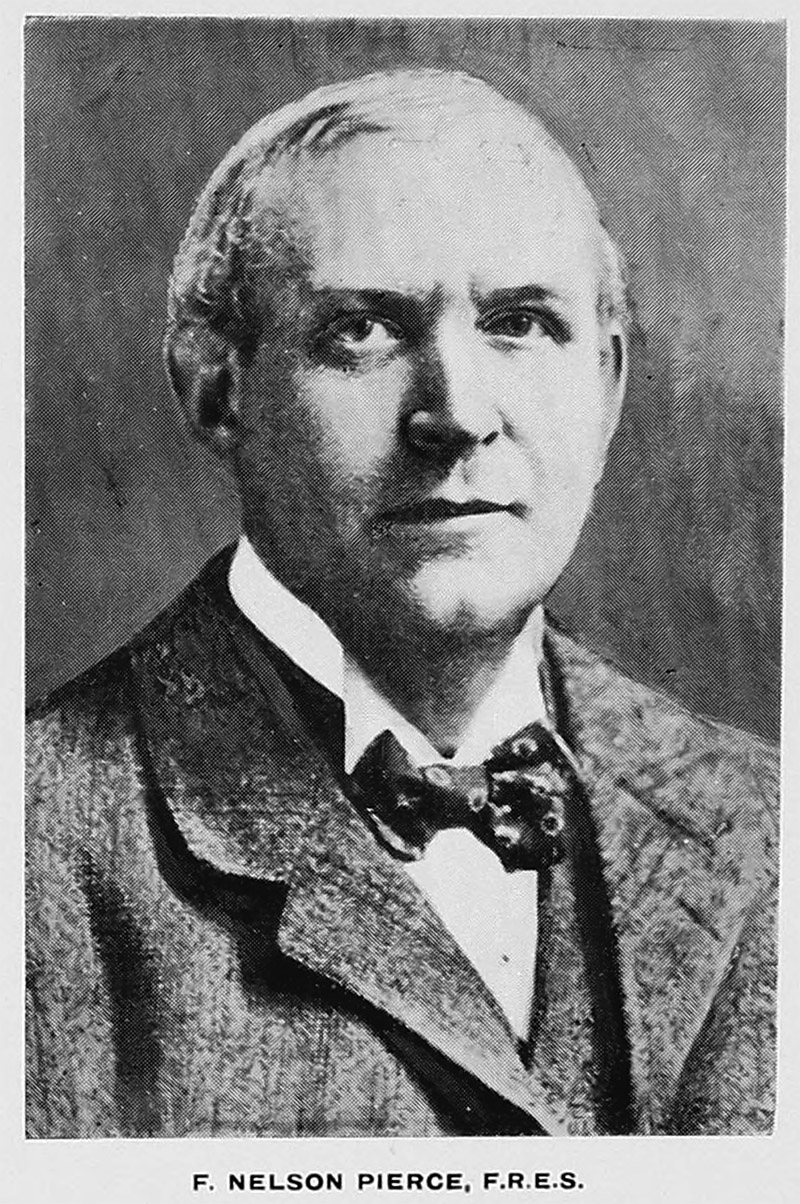
Figure 5.
F.N. Pierce, from a 1906 photograph.
Frank Nelson Pierce was born on January 27, 1862, in Liverpool, England. He was the first child of Alfred and Elizabeth (nee Nelson) Pierce. Alfred had 6 older children from a previous marriage, who ranged in ages between 1 and 8 years old at the time of his 1860 marriage to Elizabeth. His previous wife, Fanny, died shortly after giving birth to her sixth child in early 1859. Alfred and Elizabeth had Frank and two further children before Elizabeth died in 1877, at only 49 years old. Neither Frank nor his two younger siblings ever married, but instead lived together until Frank retired and left Liverpool in 1919.
Father Alfred owned a tobacco shop on Castle Street, Liverpool, which had been established by his own father. Frank and his younger brother, Grenville, later inherited the business. A memoriam of F.N. Pierce wrote, "The entomologist was a grandson of the founder of the famous tobacconist firm in Liverpool which was under the shade of the Town Hall. This quaint old-fashioned shop was on the right hand side of Castle Street approaching the Town Hall and close to Dale Street. Thomas Carlyle used to purchase his tobacco here and Mr. Pierce, who inherited the business, wrote an attractive brochure which supplies pleasing reminiscences. In this he recalls that his grandfather’s shop was the first in Liverpool to have glass windows, and at the time of writing was still the only one in the city to put up the shutters at the end of the day. It was, until comparatively recent years, a tiny, dingy-looking cabin in the heart of the business quarter. Merchants and Aldermen used to foregather there and discuss the markets. Row upon row of boxes of cigars was marked with customers’ initials, streams of office boys with wonderful collections of snuff boxes used to await the arrival of the Dublin packet boat with their masters’ snuff, and the old London stage coach is another memory of those good old days. Elections were carried on for several days, and so great was the crush that the shutters were never taken down".
Accordingly, the Pierce tobacco shop was a financial success, and the family always enjoyed the comforts of multiple domestic servants.
A later memoriam stated that "a friend recalls that the budding entomologist was collecting butterflies on Merseyside as early as 1868 when six years old". In 1881, when 19 years old and working as a "commercial clerk", Frank Pierce joined the Lancashire and Cheshire Entomological Society. His memoriam further recalled, "In his earlier years, Pierce was an ardent field collector and at that period read a number of papers dealing with definite localities where he had collected". On December 2, 1891, Pierce was elected as a Fellow of the Entomological Society of London, the country's premier society of insect studies.
Evidently inspired by an 1878 paper on the identification of lepidoptera through examination of their genital structures, Pierce focused his studies on similar characterization of that aspect of British butterflies and moths. His first major work on the topic, "The genital armature of the genus Miana", was published in The British Naturalist in 1891. A follow-up study, “Some further researches upon the genital structure of Lepidoptera", was presented to the Lancashire and Cheshire Entomological Society on September 12, 1892.
Pierce's detailed investigations of fine structures of insects required that he acquire familiarity with the microscope. Presumably inspired by his entomological studies, Pierce joined the Liverpool Microscopical Society.
Frank's father died in 1893, whereupon he and younger brother, Grenville, inherited the family's tobacco business. The 1901 census recorded Frank, Grenville, and their youngest sister, Elizabeth, living together at "The Elms" in the Toxteth Park section of Liverpool.
Meanwhile, Pierce sought specimens in preparation of his first major work on identifying lepidoptera species. In 1902, The Entomologist's Record and Journal of Variation noted that, "Mr. F.N. Pierce is busy studying the male genitalia of the Cymatophorids and Noctuids. For the purpose of making microscopic slides and illustrations for a proposed paper thereon, Mr. Pierce asks for males of the following species, condition being quite immaterial", followed by a list of some 20+ species.
The Genitalia of the Group Noctuidae of the Lepidoptera of the British Islands: An Account of the Morphology of the Male Clasping Organs was published in 1909. The title page noted that he was Vice President of the Liverpool Microscopical Society, Librarian of the Lancashire and Cheshire Entomological Society, and a Fellow of the Entomological Society of London (Figure 4). Pierce subsequently published at least five additional books on genital structures of lepidoptera.
Pierce was elected President of the Liverpool Microscopical Society in 1910.
He was also skilled at the art of taking photographs through a microscope. In 1911, Pierce contributed a number of microphotographs of insect dissections to a paper by C.R.N. Burrows, "On the nictitans group of the genus Hydroecia" (Figure 6).
A memoriam on Pierce later noted that, "Our naturalist was characterised by a singular charm of manner combined with a distinctly altruistic nature. From the age of 17 he took great interest in the Coliseum Mission in Liverpool and found time in a busy life to devote five evenings-weekly to rescue work among children. (Pierce referred) to his foundation of the 'Colly Kids Gymnasium', and he was affectionately known as 'The Slum Bishop of Liverpool'. … Children of the slums, he clothed, fed and trained them: they all loved him. There are many successful business men in different parts of the world who gratefully attributed their success to Pierce's influence and teaching".
Frank Pierce retired from business in 1919, dissolving the Pierce & Sons partnership that he had with his younger brother. He then moved to Warmington, Northamptonshire, and lived in a house known as "The Old Rectory". The Lancashire and Cheshire Entomological Society elected him as an Honorary Member, and he remained in close contact with the group until his death in 1943.
The memoriam from the Lancashire and Cheshire Entomological Society concluded with, "No tribute would be representative without reference to his marked skill in microscopy and entomological dissection. This is well displayed in those special studies in which he achieved so much and to which his monumental published work affords striking testimony. He bequeathed half of his valuable entomological collections to the British Museum (Natural History) and the remainder to the Liverpool Municipal Museums. The latter, which affords a particularly valuable and opportune accession, includes three cabinets of British Lepidoptera".
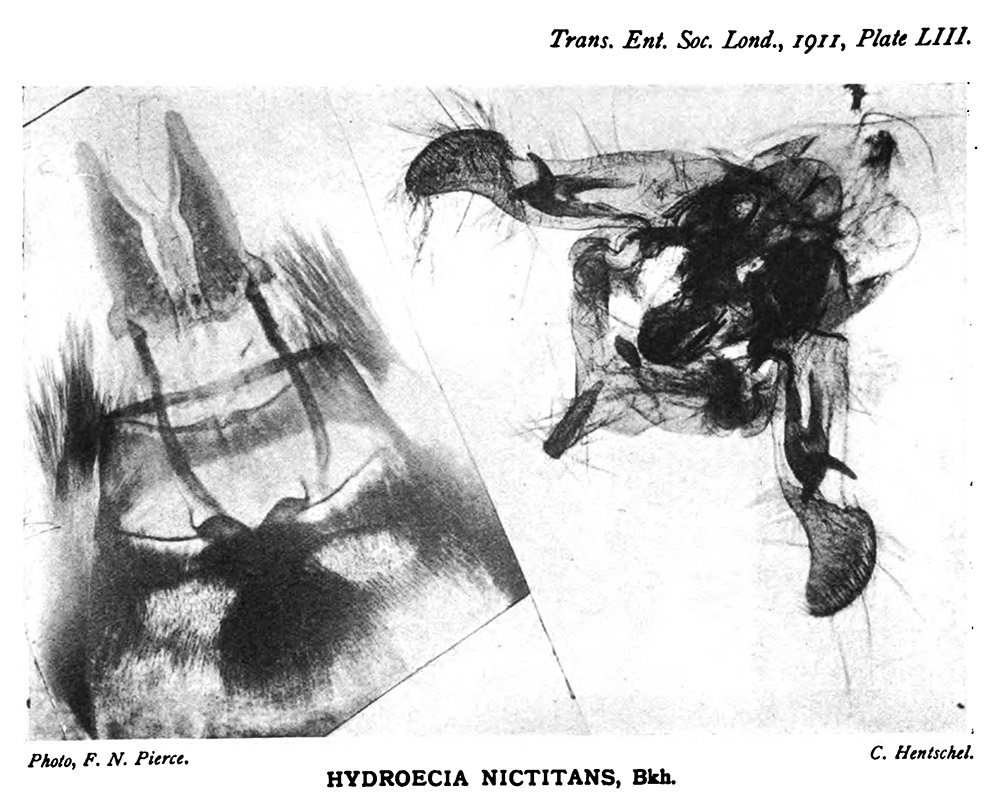
Figure 6.
Photomicrographs by Frank Pierce, for C.R.N. Burrows' 1911 paper, "On the nictitans group of the genus Hydroecia", published in The Transactions of the Entomological Society of London.
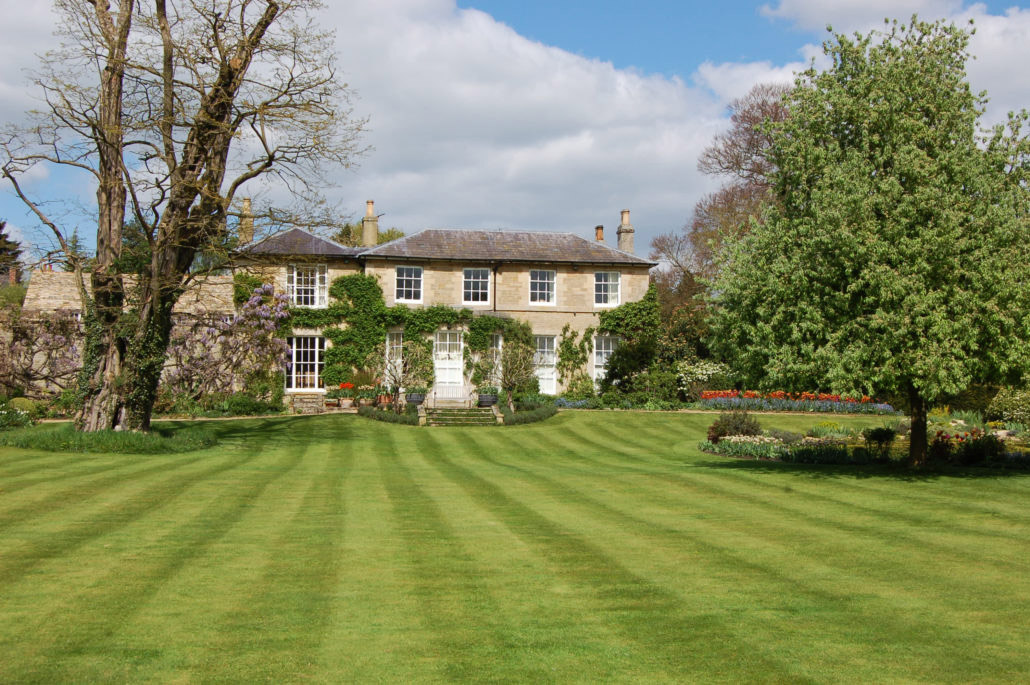
Figure 7.
F.N. Pierce retired to The Old Rectory, Warmington, in 1919. The expansive gardens and nearby countryside would have been an ideal home for the entomologist and microscopist. Image adapted for nonprofit, educational purposes from https://www.theoldrectorygardens.co.uk/
Resources
Burrows, C.R.N. (1911) On the nictitans group of the Genus Hydroecia, Gn., The Transactions of the Entomological Society of London, pages 738-749
The Commercial Directory of Liverpool (1875) "W. Pierce and Sons, cigar importers, 3 Castle street W", page 114
England census and other records, accessed through ancestry.com
The Entomologist's Monthly Magazine (1892) "Lancashire and Cheshire Entomological Society … Mr. F.N. Pierce, F.E.S., read a paper, entitled, 'Some further researches upon the genital structure of Lepidoptera'. The author described the different species in the genera Acronycta, Agrotis, Noctua, &c., and showed that in cases where the identity or otherwise of species was disputed the genitalia might often be used as a bure means of differentiation. The paper was illustrated by the author's preparations of these parts thrown upon a screen by the aid of oxy-hydrogen micro lantern, and by photographs and specimens of each species described", Vol. 28, page 270
The Entomologist's Record and Journal of Variation (1902) Note on F.N. Pierce's studies, Vol. 14, page 353
The London Gazette (1919) Dissolution of the partnership of Pierce & Sons, page 4263
Pierce, F.N. (1891) The genital armature of the genus Miana, The British Naturalist, Vol. 1, page 70
Pierce, F.N. (1909) The Genitalia of the Group Noctuidae of the Lepidoptera of the British Islands: An Account of the Morphology of the Male Clasping Organs, A.W. Duncan, Liverpool
Pierce, F.N. (1914) The Genitalia of the Group Geometridae of the Lepidoptera of the British Islands: An Account of the Morphology of the Male Clasping Organs and the Corresponding Organs of the Female, Pierce, Liverpool
Pierce, F.N., and J.W. Metcalfe (1922) The Genitalia of the Group Tortricidae of the Lepidoptera of the British Islands: An Account of the Morphology of the Male Clasping Organs and the Corresponding Organs of the Female, Pierce, Oundle, Northamptonshire
Pierce, F.N., and J.W. Metcalfe (1935) The Genitalia of the Tineid Families of the Lepidoptera of the British islands: An Account of the Morphology of the Male Clasping Organs and the Corresponding Organs of the Female, Pierce, Oundle, Northamptonshire
Pierce, F.N., and J.W. Metcalfe (1938) The Genitalia of the British Pyrales with the Deltoids and Plumes: An Account of the Morphology of the Male Clasping Organs and the Corresponding Organs of the Female, Pierce, Oundle, Northamptonshire
Pierce, F.N. (1942) The Genitalia of the Group Noctuidae of the Lepidoptera of the British Islands: An Account of the Morphology of the Female Reproductory Organs, Pierce, Oundle, Northamptonshire
Scientific and Learned Societies of Great Britain (1910) Liverpool Microscopical Society, page 163
Transactions of the Royal Entomological Society of London (1891) Election of Fellows "Mr. Frank Nelson Pierce, of 143, Smithdown Lane, Liverpool", Vol. 39, page xxi






